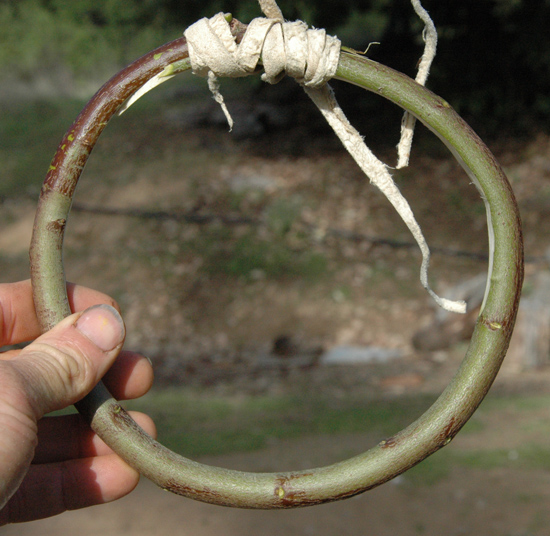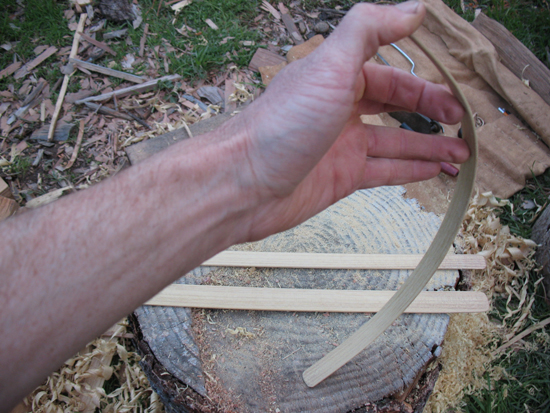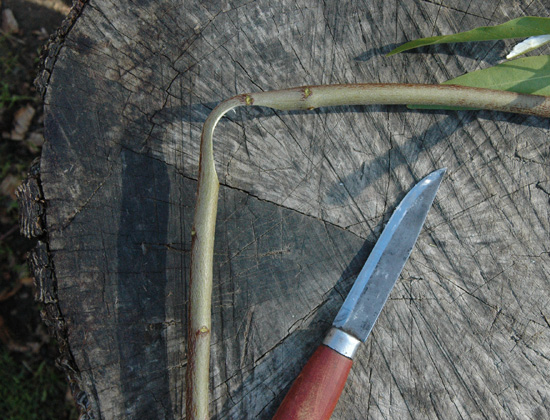By Steven Edholm Bending wood is a useful, and sometimes necessary skill. In this post I am going to present a few pieces of information which are key to successful wood bending of any kind, paleo or otherwise. The most common need for bending wood in paleotechnology is for straightening wildcrafted shafting such as arrow shafts, hand drills and atlatl darts. There are, however, many other uses for a straight stick. There are also plenty of uses for curved sticks, such as in the making of hoops and basket rims. Wood bending can be dropped neatly into the skill set of anyone who can internalize the following ideas.
*Wet (or green) wood bends more easily than dry wood. Living wood requires a degree of flexibility to adapt to it’s environment, so green or wet wood is naturally flexible. Also, if the wood is heated to assist in bending, the heat will spread more rapidly into moist wood than it will in dry wood. Some items can be bent while green, or after soaking, without any heating.
*Very fresh green wood can be slightly more brittle than barely “wilted” wood. Usually only slightly, but worth keeping in mind. Heating very fresh wood will also effectively “wilt” it.
*Hot wood bends more easily than cold wood. Like way easier, no really.
*Scorched wood is inflexible and liable to crack on bending. Wood is easily scorched during heating over hot coals. Scorching changes the character of the wood making it at once more hard and more brittle. Ideally the wood should not color at all when heated.
*Give the wood time to bend (slower is safer). Taking a gradual approach, will give the wood fibers time to stretch and compress around the new shape. Rapid sudden bending is more likely to result in cracking.
*Wood does not bend evenly around knots or other variations in thickness. Even thickness is crucial to even bends. Some variations in shape and thickness can be worked around with the hands by applying more or less pressure to certain spots, but generally it is difficult and sometimes impossible to force wood to bend where it doesn't want to. Also, wood forced to bend around variations in thickness will often revert over time as the item is exposed to variations in temperature and humidity. Thick areas can often be thinned to allow even bending, but it is best to thin on the inside of the bend so as not to violate the grain on the back where the wood has to stretch.
*Thin wood bends more easily than thick wood.
*Violations of grain are risky. a trunk or stick is made up of concentric rings of growth. Cutting across the rings violates the grain and allows the wood to separate more easily along the growth rings. when using wild wood, it is ideal to leave the back of the bend at one growth ring, even if it means leaving knots intact and raised above the surface. Sometimes you have to cut across the growth rings whether you want to or not, just be aware that the wood is stronger if they are intact.
*Quarter sawn wood is safer to bend than plain or flat sawn wood. Plain sawn wood will show layers of violated grain on the broad face of the lumber. These violations of the wood grain are likely to result in de-lamination of the layers when bent. Quarter sawn wood will show grain lines that are tightly parallel on the broad face and is more likely to hold together under bending stress.
*Thickness of the wood is crucial. Take a 1 x 4 inch board. If it is bent with the broad face out, it will bend some. If it is bent on edge, it will barely bend, if at all. Very thick or deep wood is hard to bend because there is so much wood to compress on the inside of the bend and an equal amount to stretch on the outside of the bend. A 1/2 x 4 inch board will bend more easily and a 1/4 x 4 inch yet easier. But neither of the thinner boards will bend easily in the 4 inch dimension because that 4 inches is still a limiting factor.
*Sharp bends are more likely to crack in bending than gradual bends are.
*Retain the position while drying and/or cooling. Hold the bend until the piece is cooled (if heated dry) or dry (if steamed, soaked or green). Heating and moisture provide plasticity for easy bending, so leave the piece bent until plasticity is gone in order to retain the new shape.
Whelp, that is most of what you need to know to bend wood successfully! We’ve got some cool posts in the chute on stuff like paints, fire and barktanning so stay tuned!

















